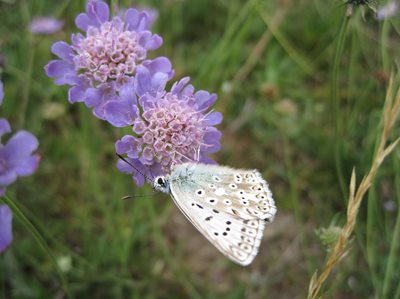Few wildflower meadows remain in Norfolk but we probably all have a roadside verge close to where we live. In many areas of Norfolk, it’s along these edges of lanes and roads that we are most likely to spot wild flowers, with even some urban verges supporting a surprising diversity of plant species.
Most people will be familiar with common daisies and dandelions but some will have noticed for a few weeks in spring the white flowers of Danish scurvy grass edging busy main roads. Originally a saltmarsh species, this plant has adapted to an environment where winter salting of roads creates a salty niche in a narrow zone edging many busy Norfolk roads.
.JPG.aspx?width=375&height=500&ext=.jpg)
Celandine, by David North
The flowers of our roadsides mark the changing seasons. February and March see the welcome appearance of celandines and primroses in tones of yellow. April brings patches of magenta with red dead-nettle and the first red campion. May is lacy white with cow parsley. June brings the fire of poppies, sky blues of scabious and waving white heads of ox-eye daisies.
This succession of flowers is vital for our bees, butterflies and other pollinators that both gardeners and farmers benefit from, as well as supporting myriad other invertebrates. In the longer grass small mammals such as shrews and voles can thrive and their predators, barn owls, kestrels, foxes, weasels and stoats all hunt along grassy verges.
Our verges are like long, thin nature reserves supporting whole communities of wildlife. Crucially they also help wildlife move through our often hostile modern landscape. These linear grasslands and their fringing hedgerows are vital corridors that birds, bats, badgers, beetles, bees and much other wildlife use, largely unnoticed by us, as their own highways to move through an often inhospitable intensively farmed countryside.
Our roadside verges, when managed sensitively, are hugely important for nature. There are 238,000 hectares of road verge grassland in Britain with Norfolk alone having more than 20,000km. Across Britain verges support more than 1,000 species of flowering plant, including some species now confined to verges.
With the loss of so many natural meadows in Norfolk today you are more likely to see a cowslip growing on a road verge than in a wild meadow. Even orchid species, from common spotted to early-purple and bee orchid, can be found thriving on a few Norfolk roadsides.
South Norfolk’s verges have also become a vital refuge for the nationally rare sulphur clover. The verges it grows on are perhaps remnants of long-vanished former commons and hay meadows. Norfolk Wildlife Trust, in a project called ‘
Seeding the Future’, has been working with local community volunteers to gather green hay from South Norfolk roadside verges to establish new refuges for this threatened species.

Scabious, by David North
Our Norfolk roadside verges have huge potential to support wildlife, some are quite literally a last refuge for endangered plant species lost elsewhere as our grasslands and meadows succumbed to plough, spray and fertilizer, the tools of a modern farmland. In Norfolk more than 100 verges have been designated as roadside nature reserves but sadly many others are poorly managed for wildlife. Many are in danger of losing their value because of over-frequent or badly timed cutting regimes that don’t allow plants to set seed.
Our landscape heritage is reflected in our road network. Many verges are ancient – lining routes once walked by people long before tarmac and cars. Cuttings and roadside banks reveal a microcosm of our geology and a time capsule revealing plant life once common across a richer and more varied countryside. Some wider verges were once hand-scythed with cuttings raked up for hay. Others were originally part of a network of trade and drove roads perhaps dating back to Roman times. Today they deserve our interest, respect and most of all our protection. So next time you take a walk on the verge remember to enjoy the wild flowers that grow there. They reveal the story of our changed and changing Norfolk countryside.
Header image by David North